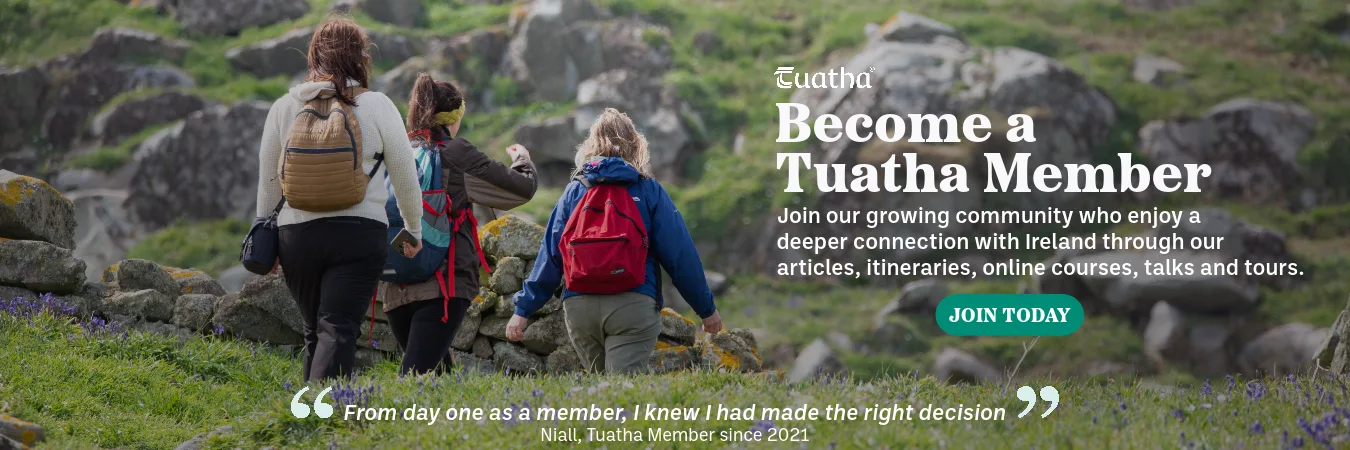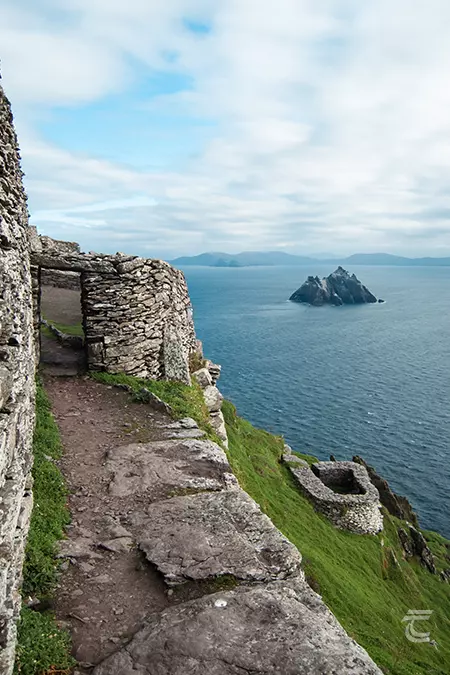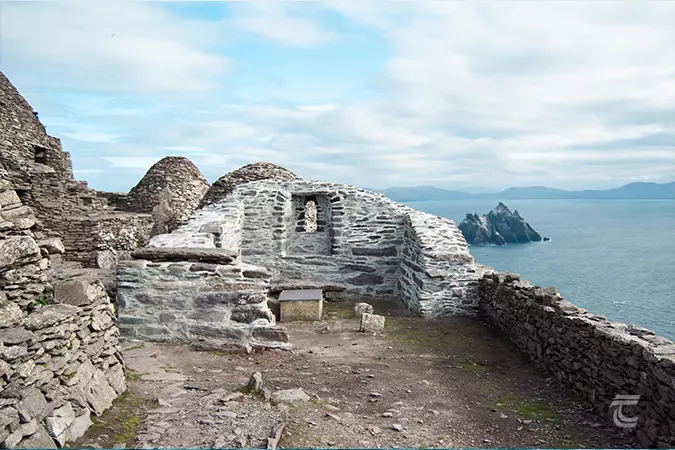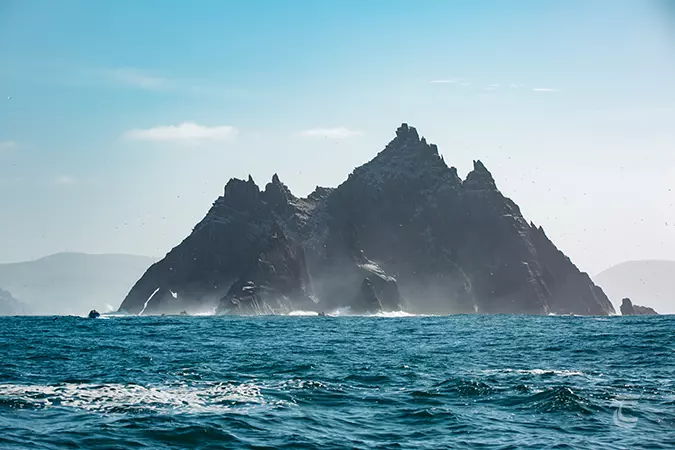Skellig Michael
The awe-inducing island of Skellig Michael, a World Heritage Site, lies some 12km (8 miles) off the coast of Bolus Head in County Kerry. The famous jagged rock that rises some 218m (715 feet) over the Atlantic waves is actually the tip of a submerged mountain, formed of the same 400 million-year-old Old Devonian Sandstone that runs all the way to the MacGillycuddy’s Reeks. After landing on the island, you are faced with a climb up hundreds of steep stone steps that lead you ever upward until you reach the enclosure of the monastery.
The monastic foundation here is thought to have been in existence from at least the 7th century. The monastery is traditionally believed to have been founded by St. Fíonán; however, by the 11th century the island and its monastery had been rededicated to St. Michael. It was founded as part of the eremitical practice of the early Irish Church, to withdraw to isolated places to worship God, unencumbered by daily life, society or politics. This sea-bound wilderness did not protect them from the Vikings, who raided Skellig Michael. The most notable raid was in 824, when the Annals of Ulster and the Annals of Inisfallen record that the Vikings kidnapped the abbot Éitgal, who died of hunger and thirst during his captivity. Skellig Michael continued to be used by a community of monks up until at least the 12th century, before the monks left the island to a new foundation at Ballinskelligs. The island continued to be used as an occasional hermitage by the Augustinian Canons of Ballinskelligs, and it remained an important place for pilgrimage up until the 19th century.
The siting of the monastery on a terrace just below the northern peak ensured that it had a south-facing aspect and that it was largely sheltered from the prevailing winds: as comfortable a place as you could possibly get on this exposed island. The monastic remains consist of a stone enclosure with two oratories, a later mortared church known as St. Michael’s Church, seven drystone clocháns (or cells), a cemetery, leachta (possible altars or pilgrim stations), with a number of cross-slabs and other similar features. It also includes water cisterns and two terraces referred to as the Upper and Lower Monks’ Gardens. There is a further set of monastic features known as ‘The Hermitage’ on the South Peak of the island, but that is inaccessible to visitors today.
The remote desolation sought by the monks of a millennia ago was already home to a thriving community, as Skellig Michael and the smaller island of Little Skellig are also important habitats for many species of flora and fauna, particularly seabirds. They are perhaps most famous for puffins (more on these below), but they are also home to gannets, kittiwakes, guillemots, storm petrels, Manx shearwaters, fulmars, black-backed gull and even peregrine falcon.
For practical information about visiting this site Click Here
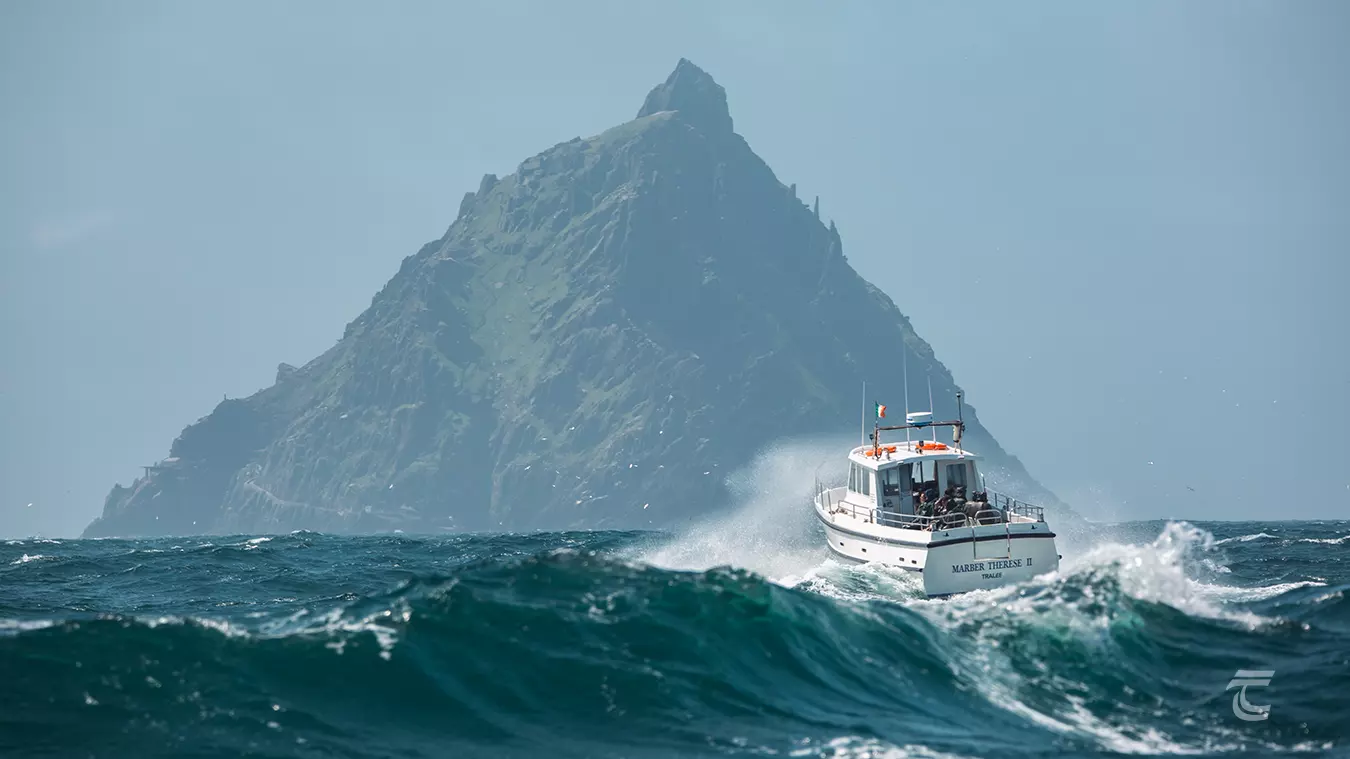
The voyage to Skellig Michael • Kerry
Visiting Skellig Michael
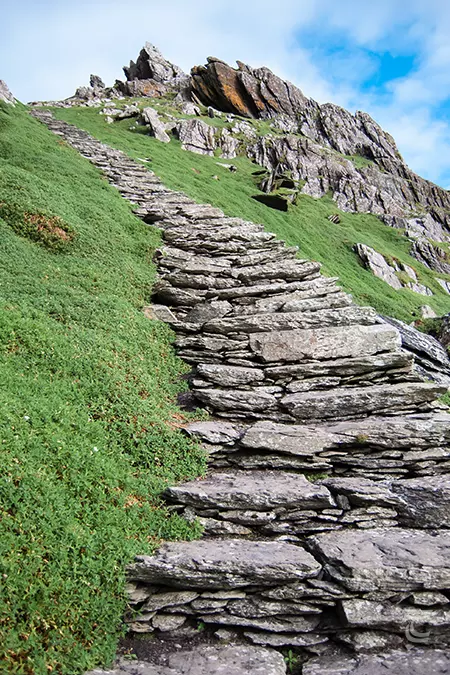
The steps leading to the monastery • Kerry
This section serves as a description of the experience of travelling to Skellig Michael based on our own trips. It is important to note from the outset that a visit to Skellig Michael requires a reasonable level of fitness and no children under the age of 12 are permitted to land.
We have had the privilege of visiting Skellig Michael three times, and we have been extremely lucky as on all three occasions the weather was favourable for the journey allowing us to land. The journey is entirely dependent on the sea conditions, and a good third of trips may be cancelled. The first voyage (this would seem like a very grand word, but given the spectacular destination it seems appropriate), was back in 2013 and it was the last day of the season in late September. In that pre-Star Wars era tickets for the boat cost €45 per person (it was €100 each for our trips in 2019 and 2021). Despite it being the autumn, the ocean was as calm as a millpond and there were few other travellers with us. The puffins had long since left, but we still had a wonderful experience and we vowed to return to this remarkable place. In 2019 we had the opportunity to do just that, and this time we really wished to go to see the island when the puffins were home, and we took an Abarta Team Trip to Skellig Michael in July 2021, a day when the island was shrouded in a thick mist that blocked the views but thankfully kept the puffins at home so we were inundated with them at every turn. Absolute Heaven!
The major difference between the first trip and the second and third is the increased demand that has been largely generated from the island featuring in the recent Star Wars trilogy. In a sense, this is a case of the island taking on a new meaning to a different sort of pilgrim, but it has meant that this fragile place is coming under increasing tourism pressure that may have a long-term detrimental effect on the natural and built heritage. The decision to allow a fragile World Heritage Site to be used in this way caused understandable, and often justifiable, controversy.
However like it or not, the decision was made and the film happened. The Jedi’s legacy may not have the same duration as the legacy as that of their early medieval forebears. From chatting to the crew of the boat and people locally, by 2019 it seemed that the Star Wars buzz had already started to wane slightly, and there were few signs or promotional messages about the film in 2021, and so this craze may not last with the same intensity for long. But Star Wars aside, there is still plenty to motivate a person to want to visit this spectacularly beautiful place for themselves, though this must always be mitigated by what is best for the island. That’s why there is a quota for the number of trips allowed each year and partially the reason for the price increases that reflect this more intense demand. A maximum number of 180 people per day can visit, on one of the 15 licensed landing tour boats each carrying only 12 passengers.

The steps leading to the monastery • Kerry
Tours to Skellig Michael
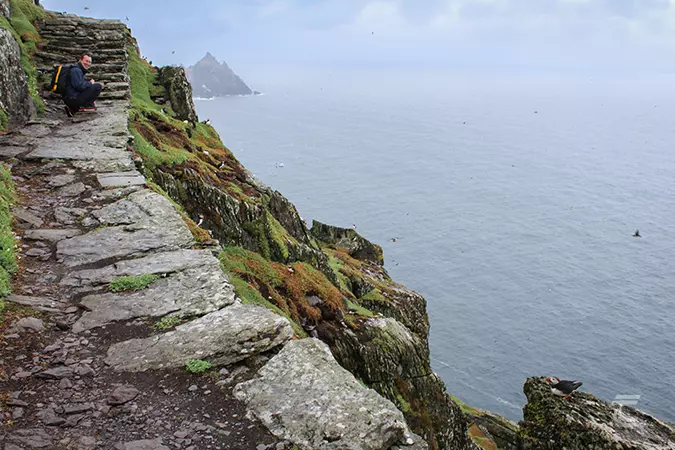
Puffin spotting on the steps of Skellig Michael • Kerry
The season usually begins in the middle of May and ends in late September. There are a number of licensed boat operators that leave from either Portmagee or Ballinskelligs. Today a visitor has two options, either a landing tour, or the less expensive ‘eco tour’ that is essentially a boat trip around Skellig Michael and Little Skellig (still a spectacular option). Tickets for the boat only generally go on sale in March and due today’s high demand landing tours can sell out very quickly. For all four of our trips so far, we have travelled with Skellig Island Tours. In 2019, with our tickets booked for the 19th July, we travelled down to the harbour at Portmagee for 8.30am. The weather did not look at all promising, with strong blustery winds and the promise of a storm. It was a somewhat anxious wait at the harbour, waiting to see if there would be a weather ‘window’ that could allow us to go, at one point it looked as if it would all be off, then all of a sudden a decision was made and we were going!
The Boat to Skellig Michael

A view from the boat on the return journey • Kerry
The 2019 trip was a rough crossing, though after they handed out the lifejackets the crew handed out crystallised ginger to calm people’s stomachs. Though it didn’t work for some. Getting on the boat can be a bit of a scramble as everyone charges for the best seats, with the ones at the back particularly sought after as being the best vantage point for photography. However, from bitter experience we’ve learned that the very worst place to sit on the boat is right at the back, as that’s where you are most exposed to the weather and spray. Instead, when possible (and particularly if the sea is a bit choppy), you should try to get the seats just either side of the boat’s cabin, where you are in the lee of a projecting roof. You also don’t feel the swell quite so bad there, so it’s certainly something to consider if the open ocean makes you queasy. While we’re on that sort of subject, there was a toilet on our boat, but some don’t have one and there are no toilets available on the island, so please be sure to go before you go! The crossing took around 50 minutes or so, the initial part of the crossing allows you to view the stunning coastline. As you approach the Skellig Islands sea birds become more and more numerous and all of a sudden the islands become clear, often creating a palpable sense of wonder on board (unless the seasickness is particularly bad, it’s hard to be awestruck when you feel like you’re turning inside-out).

A view from the boat on the return journey • Kerry
Landing on the Island
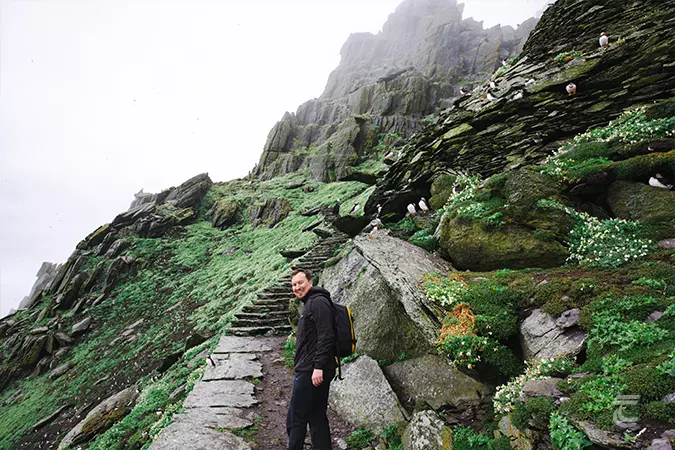
Climbing the steps under the watchful eyes of puffins • Kerry
Landing on the island involves a little hop from the moving boat onto the dock, it can be a little scary but it’s best not to overthink it and to be guided by the boat crew who have done this countless times. From there you follow the route along, and I find it hard to shake how it all feels a little surreal, that anywhere on Earth can be this beautiful, this otherworldly. That puffins are literally everywhere, a dizzying swirl of them overhead. It’s hard not to take a thousand pictures in the first 100 yards. A lot of other people are feeling like this too, and it forms an uncomfortable combination with those who want to charge up the steps as fast as they can to get the most out of their time at the monastery. In truth both impulses are perfectly correct, so torn between the two we walked along, snapping away like paparazzi in case the scenery should suddenly move elsewhere.
Climbing the Steps
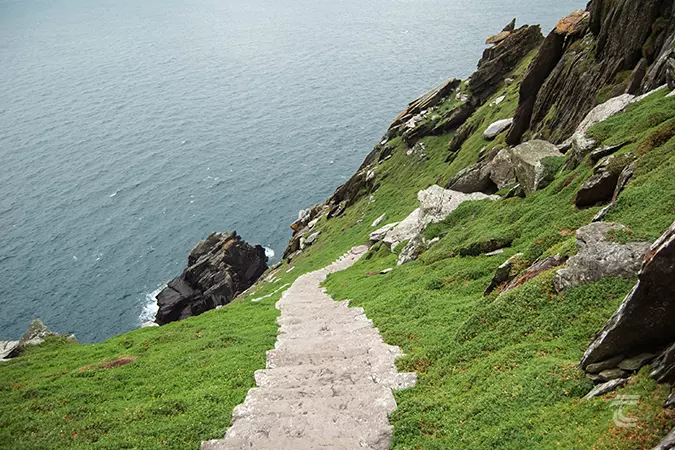
Looking down on the steps of Skellig Michael • Kerry
Finally we arrived at the base of the famous steps of Skellig Michael. People were gathered around an OPW guide who explained how to make your ascent and to stay safe (a safety video showing what to expect can be seen here). The steps are no joke. They need a certain amount of fitness, they need a good head for heights, they are narrow so they also need patience, tolerance and kindness as you’ll find yourself abruptly stopping as the person in front suddenly starts snapping pictures or gets a bit overwhelmed by the height. Tragically people have lost their lives climbing these steps, so they should be taken very seriously indeed. That said, the ascent is pretty magical, especially if you aren’t too crowded by other visitors. The puffins are just everywhere and you’ll often find them sitting right in the middle of the narrow staircase as you awkwardly try to navigate around them. If it is busy try to hold off taking pictures until you reach the safety of the ‘Saddle’ above, there will be lots of opportunities to get great pictures of them there and at the monastery.
The staircase comes in stages, one steep climb at the start followed by a narrow ledge and then up again before you arrive at Christ’s Valley (also known as the Saddle). This is a good place to take a moment to catch your breath and to enjoy the simply stunning views. Then there is one more steep set of steps, before you reach a terrace above with a narrow path leading to the entrance of the monastic enclosure.

Looking down on the steps of Skellig Michael • Kerry
The Monastery
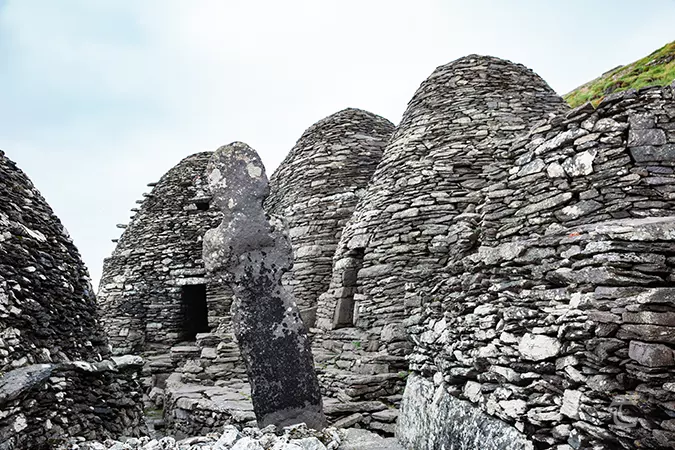
The clocháin or beehive huts of the monastery on Skellig Michael • Kerry
We encountered another bit of a log-jam as we entered the monastic enclosure. It was a particularly busy day with lots of boats landing around the same time to take advantage of the small weather window, so the monastery was full of people looking at the features and listening to the OPW guide who told them about the history of the site. Again having a bit of patience was the only recourse, and so we waited for one group to begin their descent freeing up a bit of room in the monastery. The first thing you will see after passing through the gateway is St. Michael’s Church, its white newly laid mortar makes it stand out from the rest of the drystone structures. Hopefully that will calm a little with weathering. You can go inside the clocháns, and walk in the footsteps of the early monks (or Luke Skywalker if you prefer) around the monastery. Words can barely do justice to this serenely beautiful, haunting place. It makes such an impression, I often find myself thinking of looking out over the enclosure wall towards Little Skellig, watching the puffins come and go and experiencing their occasional calls, which sound not unlike a distant lawnmower starting up ‘bwwwwwrrrRRRRRRrrrrr’. You’ll see lots of other seabirds, particularly the enormous black-backed gulls that keep the poor puffins on edge. Before you know it, and long before you’d wish it, your time is up and you must head back down.
The Descent and Return
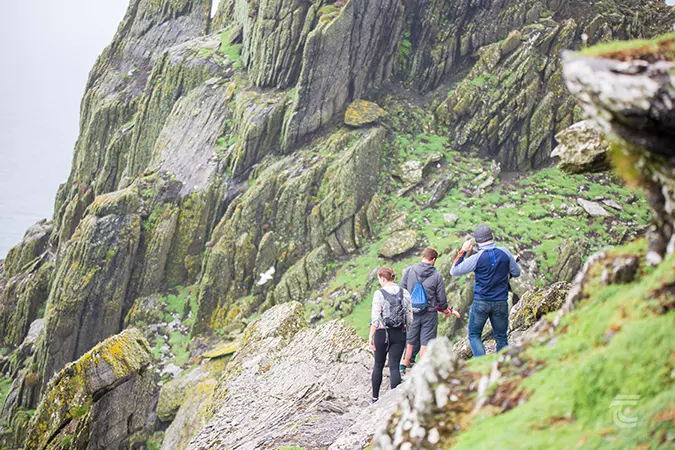
The descent from the monastery • Kerry
In many ways, heading back down the steps is more dangerous than going up. At least it certainly feels that way, given you are now looking outwards over the steep drop with very little between you and the Atlantic Ocean a long, long way below. However thanks to gravity, it moves along much quicker and less tiring than your climb and so you make fast progress. It also allows you to really appreciate the views, mainly because you aren’t focusing on the next step up, but also because by this stage you may have already had your fill of photography so you more present and able to take it in with your own eyes. Or perhaps it’s just the adrenaline from the fear that makes you feel more alive. In any case, it is hard not to feel a deep sense of awe about this remote place. You can begin to understand the attraction for those monks who lived and died here a millennia earlier. Even if you are of a cynical frame of mind, wonder is the abiding emotion on Skellig Michael.
As you descend to the lower levels your feet may become curiously reluctant, and you start snapping off hundreds more pictures and willing your mind to remember every detail – the colour of a puffin’s beak, the soft springy bright green vegetation, the dark blueish grey of the Atlantic, the pale yellow of a black-backed gull’s eye. Then you are back at the pier, and hopping back onto the boat, and it is done.
The journey back is a wonderful experience in itself. You get more time facing backwards towards the island as you leave, time to take in the shape, colour, sight and sound of it. You will also get to be brought right up to Little Skellig, to see the endless multitude of the gannet colony. The colony may be a bit loud and smelly but watching the gannets swoop, soar and dart into the water like torpedos is a wonder in itself. If you’re lucky you should also get to see grey seals resting around the base of the rocks. Then the boat engines roar into full power and you are heading back to shore. In total the experience lasted from around 8.30am up to landing again at Portmagee a little after 2pm.

The descent from the monastery • Kerry
Left: entrance to the monastic enclosure • Upper right: the interior of St Michael’s Church • Lower left: Sceilig Bheag, or Little Skellig, approximately 1.5km east-northeast of Skellig Michael
Top: entrance to the monastic enclosure • Middle: Sceilig Bheag, or Little Skellig, approximately 1.5km east-northeast of Skellig Michael • Bottom: the interior of St Michael’s Church
The Skellig Michael Puffins
The puffins of Skellig Michael • Kerry
Skellig Michael Visitor Information
Visiting the UNESCO World Heritage site of Skellig Michael, though challenging, is an incredible and unique experience. Its beauty is enhanced by it its wild remoteness and there are few places to rival it for its combination of natural and archaeological heritage.

